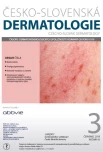-
Medical journals
- Career
Mastocytoses
Authors: Z. Plzáková; J. Štork
Authors‘ workplace: Dermatovenerologická klinika 1. LF UK a VFN, Praha přednosta prof. MUDr. J. Štork, CSc.
Published in: Čes-slov Derm, 93, 2018, No. 3, p. 91-100
Category: Reviews (Continuing Medical Education)
Overview
Mastocytosis is a group of diseases arising from the pathological increase of mast cells in tissues leading to local and/or systemic symptoms. The disease most commonly affects the skin with appearance of typical skin manifestations due to an accumulation of mast cells, the mediator symptoms arise from the release of the mast cell granule content.
Diagnosis of skin manifestations of mastocytoses is clinical and histological. In adult mastocytosis, systemic involvement should be excluded by laboratory examination, imaging methods and bone marrow biopsy. In children, the systemic form is rare and the skin manifestations mostly disappear to puberty. Systemic disease in children is considered if symptoms persist after puberty, or severe mediatory symptoms or hepatosplenomegaly are present. The mast cell therapy is based on the severity of the symptoms. It includes local treatment, phototherapy, systemic symptoms are treated by antimediator remedies and immunosuppressive therapy, anti-receptor antibodies, kinase inhibitors, in aggressive forms by cytoreductive therapy. Equally important is prevention based on elimination of physical, food or drug triggers of degranulation of mastocytes.
Key words:
mastocytosis – mast cell mediators – skin mastocytosis – systemic mastocytosis – c-kit mutation – mediator release symptoms – prognosis – dianosis – therapy
Sources
1. ALVAREZ-TWOSE, I., VAÑÓ-GALVÁN, S., SÁNCHEZ-MUÑOZ, L. et al. Increased serum baseline tryptase levels and extensive skin involvement are predictors for the severity of mast cell activation episodes in children with mastocytosis. Allergy, 2012, 67, 6, p. 813–821.
2. ARBER, D. A., ORAZI, A., HASSERJAN, R. The 2016 revision to the World Health Organization classification of myeloid neoplasms and acute leukemia. Blood, 2016, 127, 20, p. 2391–2405.
3. BUČKOVÁ, H., FEJT, J. Mastocytózy u dětí. Čes-Slov Derm, 2010, 85, 3, p. 120–138.
4. CARTER, M. C., CLAYTON, B. S., KOMAROW, H. D. Assesment of clinical findings, tryptase level, and bone marrow histopathology, in the management of pediatric mastocytosis. J. Allergy Clin. Immunol., 2015, 136, 6, p. 1673–1679.
5. DEWACHTER, P., CASTELS, M. C., HEPNER, D. L. et al. Perioperative management in patients with mastocytosis. Anesthesiology, 120, 3, p. 753–759.
6. GUPTA, K, HARVIMA, I. K. Mast cell-neurogenic interactions contribute to pain and itch. Immunol. Rev., 2018, 282, 1, p. 168–187.
7. HANNADOES, R., ROGERS, M. Presentation of cutaneous mastocytosis in 173 children. Australas J. Dermatol., 2001, 42, 1, p. 15–21.
8. HARVIMA, I. K., NILSSON, G. Mast cells as regulators of skin inflammation and immunity. Acta Derm. Venereol., 2011, 91, 6, p. 644–650.
9. HEIDE, R., MIDDELKAMP HUP, M. A., MULDER, P. G. H. et al. Clinical scoring of cutaneous mastocytosis. Acta Derm. Venereol., 2001, 81, 4, p. 273–276.
10. CHAN, A., TUNG, R. C., SCHLESINGER, T. et al. Familial cutaneous mastocytosis. Ped. Dermatol., 2001, 18, 4, p. 271–276.
11. CHATTERJEE, A., GHOSH, J., KAPUR, R. Mastocytosis – a mutated KIT receptor induced myeloprotiferative distorder. Oncotarget, 2015, 6, 21, p. 18250–18264.
12. LANGE, M., NEDOSZYTKO, B., GORSKA, A. et al. Mastocytosis in children and adults: clinical disease heterogeneity. Arch. Med. Sci., 2012, 8, 3, p. 533–541.
13. MATITO, A., CARTER, M. Cutaneous and systemic mastocytosis in children: a risk factor for anaphylaxix. Curr. Allergy Asthma Rep., 2015, 15, 5, 22. doi: 10.1007/s11882-015-0525-1.
14. MATITO, A., MORGADO, J. M., SÁCHEZ-LÓPEZ, P. et al. Management of anesthesia in adult and pediatric mastocytosis: a study of the Spanish network on mastocytosis (REMA) based on 726 anasthetic procedures. Int. Arch. Allergy Immunol., 2015, 167, 1, p. 47–56.
15. MAURER, M. MAGERL, M., METZ, M. Miltefosine a novel treatment option for mast cell-mediated disease. J. Dermatol. Treat., 2013, 24, 4, p. 244–249.
16. MOLDERINGS, G. J., HAENISCH, B., BOGDANOW, M. et al. Familial occurrence of systemic mast cell activation disease. PLOS One, 2013, 8, 9, doi: 10.1371/journal.pone.0076241. eCollection 2013.
17. MOLDERINGS, G. J., HAENISCH, B., BRETTNER, S. et al. Pharmacological treatment options for mast cell activation disease. Arch. Pharmacol., 2016, 389, 7, p. 671–694.
18. Nováková, L., Kučera, P. Systémová mastocytóza Transfuze Hematol dnes, 2009, 15, 1, p. 31–38.
19. ROTHE, M. J., GRANT_KELS, J. M., MAKKAR, H. S. Mast cell disorders: Kids are not just little people. Clin. Dermatol., 2016, 34, 6, p. 760–766.
20. STEVENS, M. T., EDWARDS, A. M. The effect of 4% sodium cromoglicate cutaneous emulsion compared to vehicle in atopic dermatitis in children-A meta analysis of total SCORAD scores. J. Dermatol. Treat., 2015, 26, 3, p. 284–290.
Labels
Dermatology & STDs Paediatric dermatology & STDs
Article was published inCzech-Slovak Dermatology

2018 Issue 3
Most read in this issue- Mastocytoses
- Evaluation of the Occurence of Basal Cell Carcinoma Dermoscopic Structures with Possible Prediction of its Histological Type
- Prurigo Pigmentosa – Case Report
Login#ADS_BOTTOM_SCRIPTS#Forgotten passwordEnter the email address that you registered with. We will send you instructions on how to set a new password.
- Career

